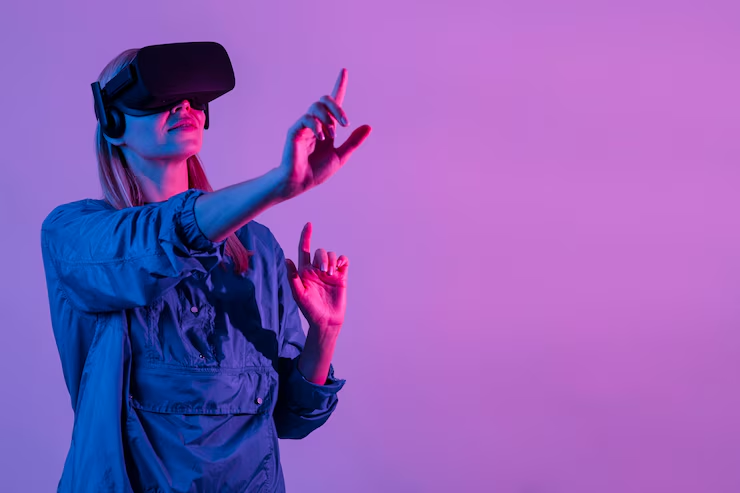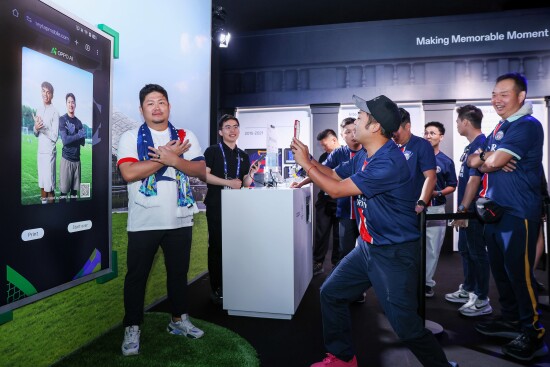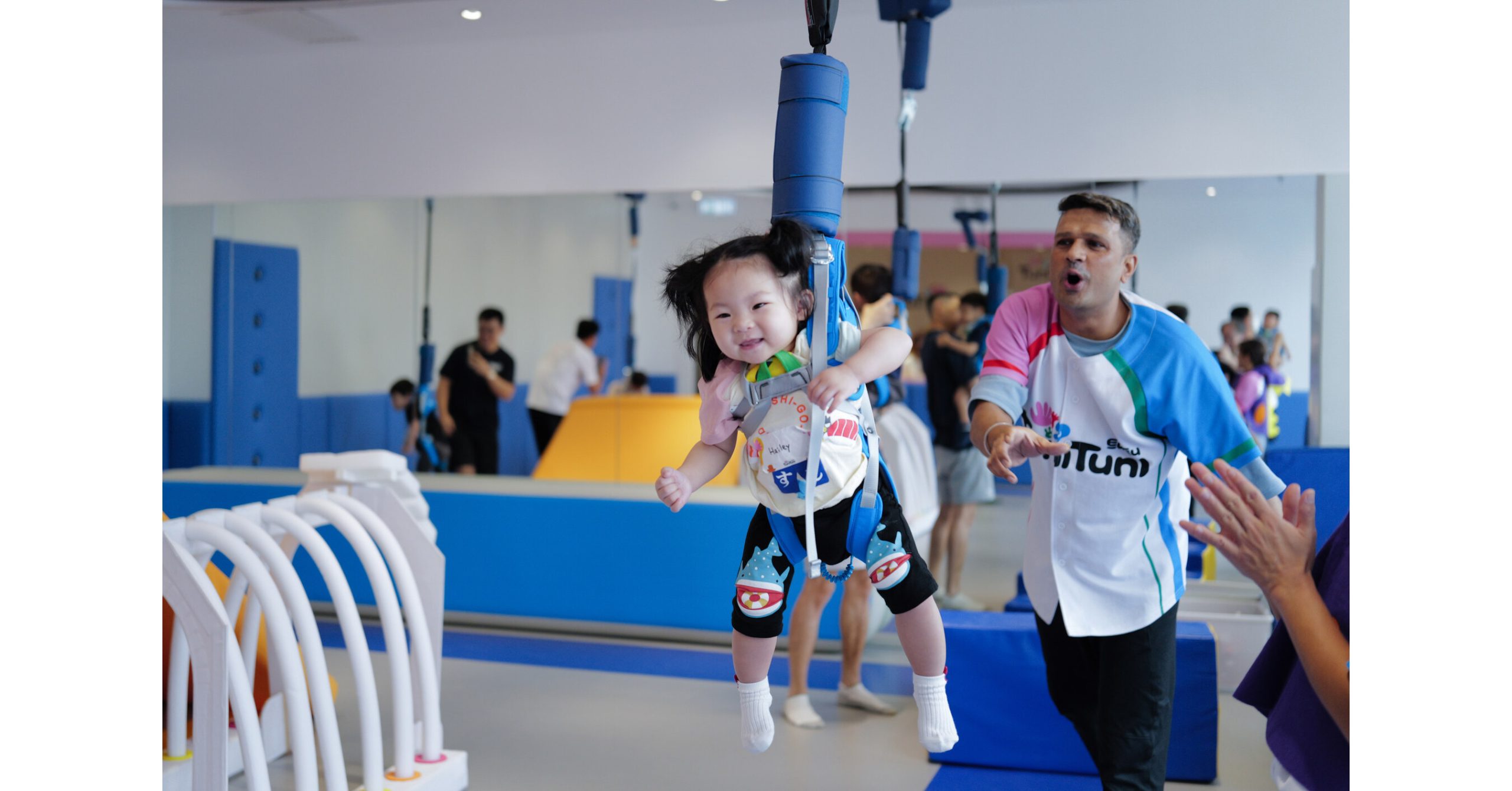Technology
Tech Trends Transforming the Way We Connect and Communicate
In the last decade, technology has dramatically reshaped how humans interact. From instant messaging to immersive virtual environments, the boundaries of connection have expanded beyond geography and time zones. The growing influence of artificial intelligence, the rise of decentralization, and the evolution of digital platforms are revolutionizing communication norms, behaviors, and expectations. As these advancements […]

In the last decade, technology has dramatically reshaped how humans interact. From instant messaging to immersive virtual environments, the boundaries of connection have expanded beyond geography and time zones. The growing influence of artificial intelligence, the rise of decentralization, and the evolution of digital platforms are revolutionizing communication norms, behaviors, and expectations. As these advancements continue to unfold, the world is witnessing a fundamental shift in how people form relationships, build communities, and share ideas.
1. The Shift to Real-Time, Cross-Platform Communication
Traditional communication methods, such as phone calls and emails, have been largely supplanted by instant messaging apps, live video tools, and collaboration platforms that support cross-device synchronization. These systems allow users to move seamlessly between mobile, desktop, and wearable devices without losing context. This shift has increased responsiveness and enabled global communication with unprecedented ease.
Furthermore, voice-to-text and speech recognition technologies now enhance accessibility, allowing individuals with disabilities or language barriers to participate more fully in digital conversations. Real-time translation tools are also narrowing linguistic gaps, enabling smoother international dialogue and remote teamwork.
2. The Role of Artificial Intelligence in Streamlining Interactions
AI plays a crucial role in enhancing communication. Natural language processing enables machines to understand, interpret, and generate human language with increasing accuracy. Chatbots and virtual assistants, for example, now handle millions of customer interactions daily, resolving queries, guiding purchases, and delivering personalized content.
More sophisticated AI moderation models can now predict conversation patterns, detect emotional cues, and even auto-generate summaries of discussions, which improves workplace efficiency and ensures key points are never lost. Sentiment analysis also allows businesses and content creators to gauge audience reactions and tailor messaging strategies accordingly.
3. The Growth of Immersive Technologies
Augmented Reality (AR) and Virtual Reality (VR) are pushing the boundaries of interaction by creating spaces where communication feels more human. These technologies are gaining traction not only in entertainment but also in education, training, therapy, and business meetings. Immersive environments enable users to engage with one another in spatially aware settings, simulating the nuances of in-person conversations.
In corporate settings, VR-powered meetings can mimic real-world interactions, reducing the fatigue often associated with traditional video calls. In educational contexts, students in different countries can now collaborate on virtual field trips or labs, gaining global perspectives in real time.
4. Decentralization and Privacy-Centric Communication
Amid growing concerns about data privacy and digital surveillance, decentralized communication tools have gained popularity. These platforms operate without centralized servers, allowing users to maintain greater control over their data and interactions. Blockchain-based messaging apps and peer-to-peer networks are offering new levels of encryption and privacy assurance.
Users are increasingly seeking systems that prioritize consent, anonymity, and data integrity. This trend reflects a broader societal demand for digital autonomy and security. As more people adopt these alternatives, traditional models of communication may face pressure to evolve and offer similar safeguards.
5. The Emergence of Asynchronous Communication Models
With the rise of global remote work and digital nomadism, asynchronous communication has become more important. Instead of requiring all parties to be present simultaneously, asynchronous tools allow users to send messages, videos, or recordings that can be accessed and responded to at different times.
This approach respects different time zones, reduces pressure for immediate responses, and fosters more thoughtful, deliberate conversations. Asynchronous communication is now embedded in project management software, team collaboration platforms, and even in emerging educational environments.
6. Intelligent Moderation and Digital Wellbeing
As more people engage online, the need to maintain healthy, respectful digital environments becomes increasingly vital. Modern communication tools are now incorporating content analysis and filtering systems to identify hate speech, spam, harassment, and other violations.
The development of AI-powered content moderation platform technologies has been central to this effort. These tools not only detect inappropriate content but also adapt based on context, language variation, and cultural nuance. In parallel, strategies rooted in trust and safety consulting have helped platforms design user experiences that prioritize psychological safety, digital well-being, and ethical transparency.
7. The Democratization of Content Creation
Advances in mobile technology and social media platforms have allowed virtually anyone to become a content creator. Video blogs, podcasts, and live streams have become integral forms of communication, enabling individuals to reach global audiences with minimal equipment.
Short-form video, in particular, has gained massive influence, fostering direct and interactive engagement. Algorithms curate personalized content streams that keep users engaged and blur the lines between personal communication and mass media. This shift has empowered grassroots movements, marginalized voices, and independent educators, reshaping the flow of information and social influence.
8. Hyper-Personalization of Communication Channels
One of the most significant trends in modern communication is hyper-personalization. Machine learning models analyze user behavior, preferences, and interaction history to deliver customized messages, recommendations, and interactions.
This trend is most visible in email marketing, app notifications, and chat systems that tailor responses to the individual. While this level of personalization can enhance relevance and engagement, it also raises questions about data ethics, manipulation, and user consent.
Organizations must balance personalization with transparency, ensuring users understand how their data is used and have the ability to opt out of intrusive practices.
9. Communication in the Age of the Metaverse
The concept of the metaverse—a persistent, shared digital space combining physical and virtual reality—is set to transform how people communicate. Early applications include virtual meeting rooms, interactive workspaces, and social hubs where users can engage through avatars.
These environments promote presence, collaboration, and creative expression in ways that traditional tools cannot. Although still in early development, the metaverse has the potential to redefine digital identity, introduce new social protocols, and reshape how individuals connect across space and culture.
10. Ethical and Regulatory Considerations
With new communication technologies come new responsibilities. Issues such as digital addiction, misinformation, and algorithmic bias require careful oversight. As governments and institutions work to regulate online spaces, communication platforms must anticipate and adapt to changing legal and ethical frameworks.
Transparency in algorithm design, robust data protection measures, and ethical AI development are now core expectations. Public trust hinges on how responsibly communication technologies are built and managed.
11. The Role of Emotional Intelligence in Digital Communication
While technology facilitates more efficient connections, emotional intelligence remains essential. Digital tone, timing, and nonverbal cues can easily be misinterpreted, leading to friction or misunderstandings. Tools that help convey emotional context—like emojis, GIFs, and visual reactions—bridge some of these gaps.
More advanced communication tools now use sentiment detection to adjust responses and flag potential conflicts. In educational and therapeutic settings, such tools are being explored to support mental health and conflict resolution.
12. The Rise of Voice-Based Interfaces
Voice-based communication interfaces are becoming increasingly common, especially with the integration of smart assistants into daily life. Users now interact with devices using spoken commands, conducting searches, setting reminders, or sending messages with minimal physical input.
This trend has implications for accessibility, reducing friction for users with disabilities or limited literacy. It also introduces new dynamics in how people multitask and interact with digital environments, reinforcing the importance of voice design in communication strategies.
13. Automation in Professional Communication
Automated workflows have entered professional communication in a big way. Automated meeting schedulers, summary generators, email response suggestions, and customer service tools are helping businesses streamline internal and external interactions.
These systems reduce human workload while ensuring consistency, accuracy, and timely follow-ups. However, over-reliance on automation can reduce authenticity, so a balance is essential. Organizations must ensure that automation serves to support—not replace—meaningful human connection.
14. Gamification and Engagement
Gamification elements are increasingly being used to enhance user engagement across communication platforms. Points, badges, leaderboards, and rewards systems can increase participation and motivation, especially in learning, training, and social media environments.
This trend reflects a deeper understanding of behavioral psychology and its application in design. Gamified communication experiences can encourage positive behavior, foster community engagement, and support long-term habit formation.
15. Looking Ahead: The Future of Digital Connection
The next frontier in communication will likely involve a fusion of biological and digital systems. Brain-computer interfaces (BCIs), biometric communication triggers, and even emotion-driven user interfaces are being researched and tested. These developments aim to create faster, more intuitive forms of connection that bypass traditional language altogether.
While promising, such innovations raise profound questions about identity, consent, and the limits of human-machine integration. As society advances toward these possibilities, inclusive dialogue and ethical foresight will be critical in shaping a future where technology enhances—rather than erodes—human relationships.
Conclusion
Technology continues to redefine how people connect, collaborate, and communicate. From AI-enhanced interactions and immersive environments to decentralized platforms and emotional intelligence tools, the pace of change is reshaping every aspect of human interaction. While these innovations present powerful opportunities, they also demand thoughtful consideration around privacy, trust, and inclusivity.
Navigating this new landscape will require a commitment to ethical design, adaptive strategies, and continuous learning. By understanding the trends shaping digital communication today, individuals and organizations can build more meaningful, secure, and human-centered ways to connect in the future.
Related
Technology
The Evolution of Sports Betting in Canada: Trends, Innovations, and What’s Next
In recent years, sports betting has undergone a dramatic transformation in Canada. What was once considered a niche activity limited to grey-market platforms and physical betting shops has evolved into a multi-billion-dollar industry with widespread digital access and government oversight. Following significant legislative changes, the Canadian sports betting scene is not only thriving but also […]

In recent years, sports betting has undergone a dramatic transformation in Canada. What was once considered a niche activity limited to grey-market platforms and physical betting shops has evolved into a multi-billion-dollar industry with widespread digital access and government oversight. Following significant legislative changes, the Canadian sports betting scene is not only thriving but also attracting attention from global operators and investors.
The turning point for Canadian sports betting came in 2021 when Bill C-218—also known as the Safe and Regulated Sports Betting Act—was passed. This legislation allowed provinces to regulate and legalize single-event sports betting, putting an end to the longstanding restriction that only permitted parlay bets through provincial lottery systems. Since then, provinces like Ontario have embraced the new framework, opening their markets to private operators and creating competitive ecosystems.
One of the most noticeable changes since the bill’s passage is the surge in digital platforms offering sports betting services. These platforms have brought with them an array of innovative features, including real-time odds, in-game betting, and tailored promotions for local markets. This digital shift has made sports betting more accessible and user-friendly than ever before, especially for younger audiences who prefer mobile-first experiences.
New Sites
In the middle of this dynamic expansion are the new betting sites Canada continues to attract. These sites are often backed by major international companies that bring years of experience from more mature markets like the UK and the US. As a result, Canadian bettors are benefiting from competitive odds, cutting-edge technology, and customer-first design. Many of these new platforms also incorporate features such as player analytics, live streaming, and AI-powered betting tips, enhancing the overall user experience.
These emerging sites are also helping drive responsible gambling initiatives. Modern betting operators must comply with provincial regulations that emphasize player protection. Features like deposit limits, self-exclusion tools, and real-time monitoring of betting behaviors are now standard. This not only helps to mitigate the risks of problem gambling but also boosts consumer confidence in the legitimacy and fairness of the industry.
As Canada’s sports betting market matures, partnerships between betting platforms and professional sports teams are becoming more common. These collaborations offer mutual benefits—teams receive sponsorship revenue while betting companies gain increased visibility and credibility. For fans, it creates an integrated experience where watching games and placing bets become part of the same ecosystem.
Challenges
However, the industry is not without its challenges. Regulatory inconsistencies between provinces, competition from unlicensed offshore operators, and the need for robust cybersecurity measures are all hurdles that stakeholders must address. Still, the overall sentiment is optimistic. Analysts project that Canada’s regulated sports betting market will continue to grow significantly in the coming years, potentially becoming one of the largest in North America.
Looking forward, innovation will be key. With advancements in virtual reality, blockchain technology, and AI, the next wave of sports betting platforms is likely to offer even more immersive and personalized experiences. Meanwhile, increased regulation and consumer education will play crucial roles in ensuring the market grows in a safe and sustainable way.
Conclusion
In conclusion, Canada’s journey into legal sports betting has been swift and impactful. With the arrival of new technologies, strong regulatory frameworks, and the emergence of new betting sites Canada welcomes each year, the landscape is becoming increasingly sophisticated. For both seasoned bettors and newcomers, the current climate presents an exciting mix of opportunity, entertainment, and innovation.
Technology
Exclusive: Huawei Band 10 With Stress Monitoring, More Features to Launch in India Under Rs. 5,000
Huawei Band 10 will launch in India soon, nearly four months after its China debut. Building upon the success of the Huawei Band 9, which was introduced in the country in January this year, the new fitness tracker from the China-based OEM is expected to offer features central to emotional wellbeing management, along with stress monitoring […]
Huawei Band 10 will launch in India soon, nearly four months after its China debut. Building upon the success of the Huawei Band 9, which was introduced in the country in January this year, the new fitness tracker from the China-based OEM is expected to offer features central to emotional wellbeing management, along with stress monitoring and improved sleep analysis. The Huawei Band 10 is said to adopt a new alloy frame for a more premium appearance, despite aiming to be accessible to the masses.
Huawei Band 10 India Launch: Expected Price, Features
According to industry sources, the Huawei Band 10 will make its India debut as soon as this week. Despite packing a plethora of health and fitness management features, the fitness tracker will be priced under Rs. 5,000. This is in line with the pricing of the previous model, the Huawei Band 9, which was launched at a “special price” of Rs. 3,999.
The fitness tracker is said to sport an aluminium alloy frame for a more refined and premium appearance, targeting style-conscious users. Images suggest that it will have similar design elements as its predecessor, including a rectangular dial and a single physical button placed at the centre of the right spine. It could be offered in multiple colourways including a blue, green, and purple option, with the dial being colour-matched to the strap.
Huawei Band 10 will build upon the fitness features offered by the Band 9 by introducing holistic health-focussed features like stress monitoring and deeper sleep analysis. It is said to bring improved design, better sensors, and a smarter experience overall, whilst keeping it accessible to the masses in terms of the pricing.
Notably, the fitness tracker was introduced in China in February, and its Indian counterpart could debut with similar features.
Huawei Band 10 Specifications
Huawei Band 10’s China variant comes with a 1.47-inch rectangular touch-supported AMOLED screen with 194 x 368 pixels resolution and 282ppi pixel density. The fitness tracker is compatible with both Android and iOS devices through Bluetooth. It is water resistant up to a 50 metre depth.
As per the company, the Huawei Band 10 comes with a suite of sensors including an accelerometer, gyroscope, and a photoplethysmography (PPG) sensor. It supports over 100 workout modes. Users can keep a check on various metrics like heart rate, SpO2, respiratory rate, and abnormal breathing. It features a new sleep heart rate variability (HRV) metric which is claimed to offer insights into the pattern, duration and quality of the wearer’s sleep.
The Huawei Band 10 can last up to 14 days on a single charge and up to three days with always-on display enabled, the company claims. It is claimed to be attain a full charge in just 45 minutes.
Technology
Innovation, health awareness, and increasing sports participation drive growth in the sports and athletic insoles market
Sports and Athletic Insoles Market Rising demand for customized, eco-friendly, and smart insoles fuels market expansion amid growing fitness trends and injury prevention awareness. NEWARK, DE, UNITED STATES, June 2, 2025 /EINPresswire.com/ — The global Sports and Athletic Insoles Market is projected to witness significant expansion, growing from an estimated USD 10.2 billion in 2025 […]


Sports and Athletic Insoles Market
Rising demand for customized, eco-friendly, and smart insoles fuels market expansion amid growing fitness trends and injury prevention awareness.
NEWARK, DE, UNITED STATES, June 2, 2025 /EINPresswire.com/ — The global Sports and Athletic Insoles Market is projected to witness significant expansion, growing from an estimated USD 10.2 billion in 2025 to USD 18.9 billion by 2035. This impressive growth trajectory is expected to be driven by a compound annual growth rate (CAGR) of 6.8% during the forecast period, fueled by rising consumer awareness about foot health, technological advancements in insole materials, and increasing participation in sports and fitness activities worldwide.
Discover Insights into the Market Request Your Sample Report!
https://www.futuremarketinsights.com/reports/sample/rep-gb-12902
Market Overview and Growth Drivers
The demand for high-performance sports and athletic insoles has surged as athletes and fitness enthusiasts seek improved comfort, injury prevention, and enhanced performance. Key drivers propelling this growth include:
• Increasing awareness of foot-related health issues such as plantar fasciitis, flat feet, and pronation problems, which has prompted both professional athletes and casual exercisers to invest in customized and ergonomic insoles.
• Technological innovation in materials and design, including the use of memory foam, gel cushioning, and biomechanical insoles that offer superior shock absorption and support tailored to specific sports activities.
• Rising participation in sports and fitness activities globally, driven by health-conscious consumers aiming to enhance their athletic performance and reduce the risk of foot and lower limb injuries.
Emerging Trends in Sports and Athletic Insoles Market
The market is witnessing several notable trends that are shaping its future trajectory:
• Integration of smart technology: Development of smart insoles embedded with sensors to monitor gait, pressure distribution, and other biomechanical metrics in real time, providing athletes with actionable insights.
• Sustainability focus: Increased adoption of eco-friendly materials and manufacturing processes in the production of sports insoles, aligning with the global push towards sustainable and environmentally responsible products.
• Customization and personalization: Growing demand for bespoke insoles tailored to individual foot anatomy and specific athletic needs, facilitated by advancements in 3D scanning and printing technologies.
Discover new opportunities and gain transformative insights with our Health & Wellness Sector Reports! https://www.futuremarketinsights.com/industry-analysis/health-and-wellness
Challenges Confronting the Market
Despite robust growth prospects, the sports and athletic insoles market faces several challenges:
• High production costs of technologically advanced and customized insoles may limit accessibility for price-sensitive consumer segments.
• Lack of consumer awareness in emerging markets about the benefits of specialized insoles can impede market penetration.
• Competition from alternative footwear technologies and inserts that may offer overlapping benefits, requiring continuous innovation and differentiation by market players.
Opportunities for Market Expansion
Significant opportunities exist for companies willing to innovate and expand their footprint:
• Untapped markets in developing regions, where rising disposable income and growing interest in fitness activities present a fertile ground for market growth.
• Collaborations with sports teams, athletes, and healthcare professionals to promote the benefits of advanced insoles, enhancing brand credibility and consumer trust.
• Expansion in e-commerce and direct-to-consumer sales channels, leveraging digital platforms to reach a broader audience with personalized marketing and product customization options.
Key Players
• Aetrex
• Foot Balance System Ltd.
• Gravitas
• Protalus
• Currex GmbH
• Implus Footcare LLC
• Powerstep
• Superfeet
• Sorbothane
• Scholl’s Wellness Company
Get Full Access of this Report:
https://www.futuremarketinsights.com/reports/sports-and-athletic-insole-market
Market Segmentation – Sports and Athletic Insoles Market
By Product Type:
Gel Insoles, Foam Insoles, Custom Orthotics, Heated Insoles, and Others.
By Sales Channel:
Supermarkets/Hypermarkets, Specialty Stores, Online, Pharmacies/Drug Stores, and Others.
By Application:
Running, Walking, Basketball, Soccer, Hiking, and Others.
By Region:
North America, Latin America, Europe, South Asia, East Asia, Oceania, and the Middle East & Africa (MEA).
Explore Related Research Reports on Health & Wellness Industry
Safety Eyewear Market Analysis – Size, Share, and Forecast to 2035:
https://www.futuremarketinsights.com/reports/safety-eyewear-market
Men’s Skincare Products Market – Size, Share & Forecast to 2035:
https://www.futuremarketinsights.com/reports/mens-skincare-products-market
Yoga and Meditation Service Industry Analysis in Europe Share & Forecast to 2035:
https://www.futuremarketinsights.com/reports/yoga-and-meditation-service-industry-analysis-in-europe
France Adult Diaper Market Analysis by Growth, Trends and Forecast to 2035:
https://www.futuremarketinsights.com/reports/adult-diaper-industry-analysis-in-france
Women Hygiene Care Product Market Growth, Trends and Forecast to 2035:
https://www.futuremarketinsights.com/reports/women-hygiene-care-product-market
About Future Market Insights (FMI)
Future Market Insights, Inc. (ESOMAR certified, recipient of the Stevie Award, and a member of the Greater New York Chamber of Commerce) offers profound insights into the driving factors that are boosting demand in the market. FMI stands as the leading global provider of market intelligence, advisory services, consulting, and events for the Packaging, Food and Beverage, Consumer Technology, Healthcare, Industrial, and Chemicals markets. With a vast team of over 400 analysts worldwide, FMI provides global, regional, and local expertise on diverse domains and industry trends across more than 110 countries.
Contact Us:
Future Market Insights Inc.
Christiana Corporate, 200 Continental Drive,
Suite 401, Newark, Delaware – 19713, USA
T: +1-347-918-3531
For Sales Enquiries: sales@futuremarketinsights.com
Website: https://www.futuremarketinsights.com
LinkedIn| Twitter| Blogs | YouTube
Ankush Nikam
Future Market Insights, Inc.
90966 84197
email us here
Visit us on social media:
LinkedIn
Facebook
YouTube
X
Legal Disclaimer:
EIN Presswire provides this news content “as is” without warranty of any kind. We do not accept any responsibility or liability
for the accuracy, content, images, videos, licenses, completeness, legality, or reliability of the information contained in this
article. If you have any complaints or copyright issues related to this article, kindly contact the author above.
![]()
Technology
OPPO and the UEFA Champions League Final: Powering Football Innovation On and Off the Pitch | Corporate
MUNICH, GERMANY – Media OutReach Newswire – 1 June 2025 – The 2024/25 UEFA Champions League season reached its spectacular conclusion on 31 May at Munich Football Arena. As the Official Smartphone Product Partner of the prestigious competition for the third consecutive year, OPPO celebrated the event with a series of football-related CSR programs and […]

MUNICH, GERMANY – Media OutReach Newswire – 1 June 2025 – The 2024/25 UEFA Champions League season reached its spectacular conclusion on 31 May at Munich Football Arena. As the Official Smartphone Product Partner of the prestigious competition for the third consecutive year, OPPO celebrated the event with a series of football-related CSR programs and cultural activations around the final as well as reaffirming its commitment to supporting football through innovation in technology and social initiatives. By integrating cutting-edge technology into football and strengthening connections between fans and the game worldwide, OPPO continues to empower footballers and supporters to truly “Make Your Moment”, creating unforgettable experiences both on and off the pitch.
 |
| Fans take a virtual selfie with virtual Lamine Yamal powered by OPPO AI |
Watch the Game Like Never Before with OPPO Technology
Inside the Champions Village at Munich Football Arena, OPPO brought together football culture, highlights from the UEFA Champions League history, and the sporting spirit of Munich alongside the company’s latest AI technologies and camera innovations. Football fans from around the world were given the chance to take AI-powered selfies with a virtual avatar of Spanish football prodigy and OPPO Global Brand Ambassador, Lamine Yamal, at the interactive booth, making their own hero moment powered by OPPO AI. Inter Milan legend, Marco Materazzi, also made a surprise appearance at the OPPO Hospitality Lounge, where he met with fans and demonstrated the latest OPPO technology.
Alongside the OPPO and UEFA Champions League highlights on display at the Champions Village, the event also featured a showcase of OPPO’s latest AI and photography technology. Pushing the boundaries of smartphone photography, OPPO’s new camera zoom technology eliminates typical user challenges when shooting photo and video from a distance, enabling even spectators in the highest stands to capture stunning close-ups as if standing on the sidelines. Enhanced by other OPPO AI features like AI Unblur and AI Eraser, OPPO’s camera technology empowers fans to effortlessly capture goals, saves, and more epic moments, transforming the on-pitch excitement into timeless, unforgettable memories.
 |
| Legendary moments on the pitch captured by OPPO technology |
Creating a Global Platform for Football Culture Through Technology
On the eve of the UEFA Champions League Final, OPPO invited Global Brand Ambassador Kaká, and Brazilian football legend Cafu, to lead a series of charity football training clinics for youth athletes from Brazil in Munich, providing a rare opportunity for the young footballers to learn directly from their football idols. Following the training, former England international and popular broadcaster, Micah Richards also joined for an exclusive 5v5 match with the up-and-coming players, with the legends using OPPO’s AI-powered technology to capture picture-perfect moments from the pitch.
On the day of the final, OPPO also brought together Kaká, UEFA Champions League legend Esteban Matías Cambiasso Deleau, and Chinese youth women footballers for a game of the ancient Chinese football-like sport, Cuju, connecting diverse football cultures past and present while showcasing football’s unifying power.
Through this extensive program of activities around the competition, OPPO is creating a global platform that connects fans and players around the world through the common language of football. By helping to promote football, improve players’ technical skills, and provide inspiration from football heroes, these programs create valuable opportunities for youth development, elevating both the game and football culture globally.
 |
| Kaká, Micah Richards and Cafu coached and played a friendly 5v5 game with young players from Brazil |
Empowering the Next Generation of Footballers Worldwide Through Community Programs
Alongside its activations at this year’s final, OPPO has been implementing a range of diverse sports development and talent cultivation programs worldwide throughout the season in its third year as the Official Smartphone Product Partner of the UEFA Champions League.
In Brazil, OPPO has launched a comprehensive sports initiative across four communities in São Paulo to support youth football development. The program includes renovating local football pitches, donating sports equipment and supplies, providing professional training sessions, and facilitating pathways for young players to enter professional clubs.
In Egypt, OPPO teamed up with The Maker Football School for The Maker OPPO Dream League—a nationwide youth football tournament aimed at discovering and developing Egypt’s top young football talent. In addition to hosting the competitive tournament, OPPO has provided comprehensive coaching and world-class player development programs to help aspiring young footballers turn their dreams into reality.
In Mexico, OPPO also announced a strategic partnership with UNESCO, the municipal institutes of Sports of Puebla and Chihuahua to empower aspiring young football players across the country. Through the collaboration, OPPO will provide essential training equipment and cutting-edge technology to nurture the next generation of football talent and inspire professional football aspirations among local youth.
 |
| OPPO is partnering with UNESCO, the municipal institutes of Sports of Puebla and Chihuahua to support aspiring young football players in the country. |
Since beginning its partnership with the UEFA Champions League, OPPO has continued to empower football fans worldwide, with its advanced technologies and products making it easy than ever for fans to capture, share, and relive the game’s most thrilling moments. Inside the stadium, OPPO’s cutting-edge devices enable fans to preserve iconic match highlights and amplify their passion for football. Beyond the stadium, OPPO is also collaborating with global communities to provide development platforms, resources, and technologies that drive the sustainable growth of football.
Moving forward, OPPO remains committed to connecting football fans worldwide through technology and unlocking the sport’s untapped potential while empowering more football players and fans to “Make Your Moment”.
Hashtag: #OPPO #MakeYourMoment #OPPOxUCL25
The issuer is solely responsible for the content of this announcement.
News Source: OPPO
01/06/2025 Dissemination of a Financial Press Release, transmitted by EQS News.
The issuer is solely responsible for the content of this announcement.
Technology
TuniTuni Opens New Storytelling Kids’ Gym in Shek Mun, Hong Kong
HONG KONG, June 2, 2025 /PRNewswire/ — TuniTuni, the beloved Korean kids’ gym brand, is thrilled to announce the opening of its second Hong Kong center in Shek Mun on 1st June 2025. Located at Unit N, P. 19/F Kings Wing Plaza 2, No 1 On Kwan Street, Shatin, this new facility follows the phenomenal success […]

HONG KONG, June 2, 2025 /PRNewswire/ — TuniTuni, the beloved Korean kids’ gym brand, is thrilled to announce the opening of its second Hong Kong center in Shek Mun on 1st June 2025. Located at Unit N, P. 19/F Kings Wing Plaza 2, No 1 On Kwan Street, Shatin, this new facility follows the phenomenal success of its first location, TuniTuni Lohas, which launched in 2024. Due to overwhelming demand, we’re expanding TuniTuni centers to serve more families, bringing our unique “storytelling gym” experience to even more children across the city.
A child enjoys a storytelling gym session at TuniTuni’s new Shek Mun center in Hong Kong.
TuniTuni Lohas made waves in its debut year. Since its opening, over 2,500 students have experienced the TuniTuni program. The center has since been in great demand, with a long waiting list of eager families. Parents have consistently praised the excellent program and the sheer joy it brings their children, highlighting how TuniTuni’s innovative approach fosters a love for movement through “learn and jiggle, play and giggle.”
Building on this success, the new Shek Mun center is already off to a remarkable start, with more than 300 trial students registered even before the official opening. This overwhelming response underscores TuniTuni’s reputation for delivering engaging, fun, and educational experiences that captivate young minds and bodies.
“Our mission is to create a space where kids can explore, grow, and have fun through dynamic storytelling and active play,” said Mr. Austin Oh, CEO at TuniTuni Hong Kong. “The incredible feedback from parents and the enthusiasm of our young members inspire us to bring TuniTuni’s magic to more communities.”
The Shek Mun center will feature TuniTuni programs, designed to spark creativity and promote physical development in a joyful environment. Families can look forward to the same high-quality experience that has made TuniTuni a household name among Hong Kong parents.
For more information about TuniTuni Shek Mun, including class schedules and registration details, visit www.tunituniglobal.com or contact WhatsApp [852-5645 5370].
Join us at TuniTuni, where every class is a story, and every movement is a moment of delight!
About Daekyo Hong Kong
Daekyo Hong Kong is the Hong Kong subsidiary of Daekyo, a leading global education company founded in 1976. Operating in 19 countries worldwide, Daekyo is dedicated to providing personalized education tailored to each child’s level. Daekyo Hong Kong has proudly operated the Eye Level brand, focusing on English and Mathematics education, since 1997. Expanding its offerings, the company also launched and has been successfully operating the TuniTuni early childhood physical education brand since June 2024.
SOURCE TuniTuni Hong Kong

Technology
Illinois Democrats pass budget in final minutes with sports betting tax hike
SPRINGFIELD — Illinois lawmakers approved a $55.2 billion state budget package minutes ahead of a key constitutional deadline Saturday night, relying on tax hikes that would hit smokers, gamblers and big out-of-state companies to help seal an estimated $1 billion shortfall. Democratic leaders cut it down to the final seven minutes on the clock of […]

SPRINGFIELD — Illinois lawmakers approved a $55.2 billion state budget package minutes ahead of a key constitutional deadline Saturday night, relying on tax hikes that would hit smokers, gamblers and big out-of-state companies to help seal an estimated $1 billion shortfall.
Democratic leaders cut it down to the final seven minutes on the clock of May, but avoided the public intra-party squabbling that marked the chaotic conclusion of last spring’s legislative session. The main budget bill cruised through Democratic supermajorities despite strong progressive opposition to slashing a state health care program for immigrants without legal status.
“It’s not perfect, but vote yes,” state Rep. Eva-Dina Delgado said on the House floor before a 75-41 budget bill vote that saw only two suburban Democrats defect. Several more Senate Democrats voted against party lines on the other budget measures.
Delgado is part of the Latino Caucus that opposed slashing the Health Benefits for Immigrant Adults to help cut $400 million from the spending plan as recommended by Gov. JB Pritzker. The reduction would yank coverage from nearly 33,000 people in Illinois, including 22,000 in Cook County.
State Rep. Lisa Hernandez, D-Cicero, said she had still considered withholding her vote in the waning hours of the session, but the deputy majority leader ended up on board with the plan advanced by Illinois House Speaker Emanuel “Chris” Welch and state Senate President Don Harmon.
“It’s a budget that’s gonna hurt,” Hernandez said. “The investment that we put in really brought down a lot of costs when you’re talking about charitable care at hospitals.”
In a statement, Harmon said, “We all wish we could do more. But this is a responsible, balanced budget that continues our work to improve the lives of the great people of the great state of Illinois.”
Pritzker said in a statement he would sign the budget plan.
“Even in the face of Trump and Congressional Republicans stalling the national economy, our state budget delivers for working families without raising their taxes while protecting the progress we are making for our long-term fiscal health,” he said.
Legislators did retain $110 million in the budget for a similar program limited to adults 65 or older without legal status, but Hernandez said it could be the last year of such funding as the state grapples with the looming specter of deep federal funding cuts under President Donald Trump’s administration.
That uncertainty compounded the billion-dollar shortfall lawmakers ended up bridging in part by slapping taxes of a quarter or 50 cents on every online sports wager — a measure that would hit DraftKings and FanDuel just a year after legislators imposed a hefty graduated tax system on the booming industry.
Taxes were also set to be boosted up to 45% on cigarettes, e-cigarettes, nicotine pouches and chewing tobacco.
And while legislators dropped a proposal to impose a 10% digital advertising tax on tech companies like Facebook, a new method of taxing large out-of-state companies for their Illinois presence was expected to churn out an additional $72 million while a tax amnesty program was expected to claw back some $198 million from delinquents.
“We’re presenting a budget that meets this moment. It is balanced through smart cuts and through smart revenues, not balanced on the backs of working families,” said state Rep. Robyn Gabel, an Evanston Democrat and one of the top House budget negotiators. “It uses the best information we have at this uncertain time to make the best decisions for our state.”
Last year, it took House Democrats three last-minute tries to pass a spending bill. This year, members in the lower chamber toed the party line closer than their Senate colleagues. Even state Rep. Fred Crespo, D- Hoffman Estates, voted in support of the budget weeks after being booted from the caucus by Illinois House Speaker Emanuel “Chris” Welch for floating alternate proposals.
Superminority Republicans, boxed out of budget talks as usual, roundly bashed the Democratic plan.
“You know how it’s a bad budget? When it starts out with at least $1 billion in taxes,” said Senate Minority Leader John Curran, R-Downers Grove.
House Minority Leader Tony McCombie, R-Savanna, slammed Democrats for including nearly 5% pay raises for General Assembly members, increases that are tied to inflation under state law.
“Speaker Welch said the quiet part out loud: tax-and-spend Democrats are thriving in Illinois — at the expense of Illinois families,” McCombie said.
While state legislators routinely pass budgets in the wee hours of spring sessions in the Capitol, Democrats were under the gun to get it all done before the clock struck midnight into June 1, when bills constitutionally require a three-fifths majority to pass, not just a simple one.
The final bill was approved by the House at 11:53 p.m., little more than a day after the first spending details were publicly unveiled after months of negotiations behind closed doors.
“We’re supposed to be vetting this stuff. We’re not doing our jobs,” said state Rep. John Cabello, R-Machesney Park.
-

 College Sports2 weeks ago
College Sports2 weeks agoPortal Update – Basketball and Gymnastics Take Hits
-

 Rec Sports3 weeks ago
Rec Sports3 weeks agoThe Program, a New Basketball Training Facility, Opening in Greenpoint This September
-

 College Sports2 weeks ago
College Sports2 weeks agoPortal Update – Basketball and Gymnastics Take Hits
-

 Professional Sports2 weeks ago
Professional Sports2 weeks agoJon Jones answers UFC retirement speculation as fans accuse champion of 'holding the belt …
-

 Technology3 weeks ago
Technology3 weeks agoReal-life companies pump up promotions around fictional team in new ‘F1′ movie
-

 NIL7 days ago
NIL7 days ago2025 NCAA Softball Tournament Bracket: Women’s College World Series bracket, schedule set
-

 Youtube3 weeks ago
Youtube3 weeks agoStephen A.’s message to Draymond Green
-

 Youtube3 weeks ago
Youtube3 weeks agoWhen Stephen Curry Shocked The World
-

 Health2 weeks ago
Health2 weeks agoBYU women's basketball guard injures ACL twice
-

 Youtube3 weeks ago
Youtube3 weeks ago20 years ago, LeBron James made his debut on ESPN. Now, Bronny follows in his footsteps on ESPN2












 + 2025 NBA Finals Preview
+ 2025 NBA Finals Preview  | SportsCenter
| SportsCenter























